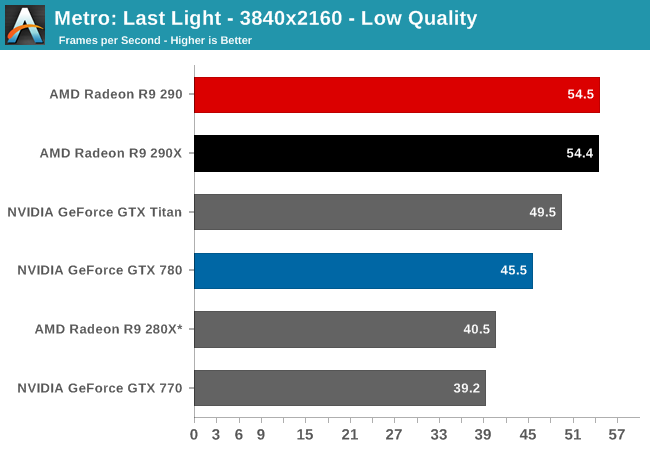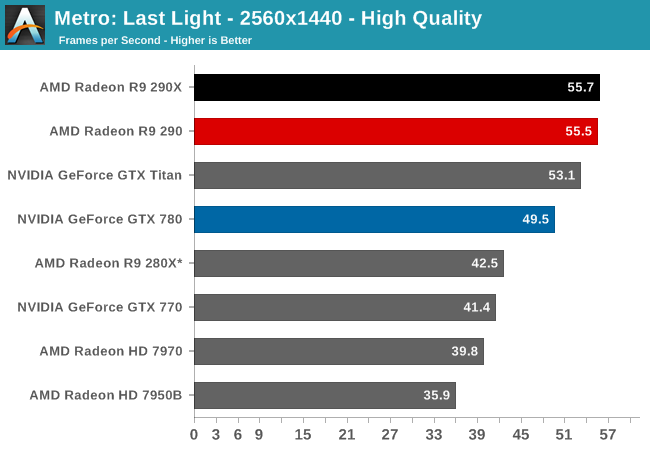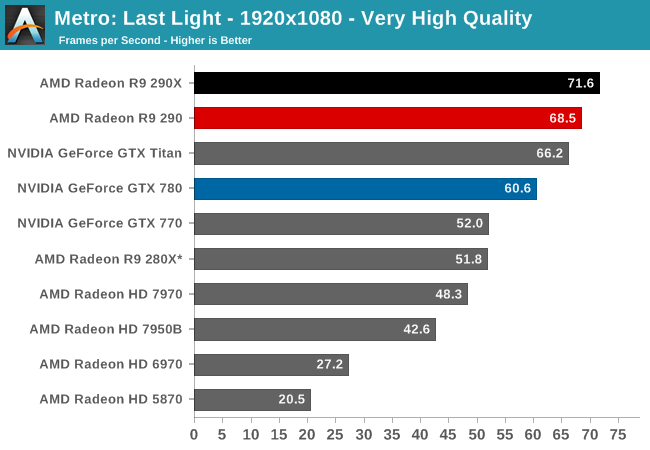The AMD Radeon R9 290 Review
by Ryan Smith on November 5, 2013 12:01 AM EST- Posted in
- GPUs
- AMD
- Radeon
- Hawaii
- Radeon 200
Metro: Last Light
As always, kicking off our look at performance is 4A Games’ latest entry in their Metro series of subterranean shooters, Metro: Last Light. The original Metro: 2033 was a graphically punishing game for its time and Metro: Last Light is in its own right too. On the other hand it scales well with resolution and quality settings, so it’s still playable on lower end hardware.



For the bulk of our analysis we’re going to be focusing on our 2560x1440 results, as monitors at this resolution will be what we expect the 290 to be primarily used with. A single 290 may have the horsepower to drive 4K in at least some situations, but given the current costs of 4K monitors that’s going to be a much different usage scenario. The significant quality tradeoff for making 4K playable on a single card means that it makes far more sense to double up on GPUs, given the fact that even a pair of 290Xs would still be a fraction of the cost of a 4K, 60Hz monitor.
With that said, there are a couple of things that should be immediately obvious when looking at the performance of the 290.
- It’s incredibly fast for the price.
- Its performance is at times extremely close to the 290X
To get right to the point, because of AMD’s fan speed modification the 290 doesn’t throttle in any of our games, not even Metro or Crysis 3. The 290X in comparison sees significant throttling in both of those games, and as a result once fully warmed up the 290X is operating at clockspeeds well below its 1000MHz boost clock, or even the 290’s 947MHz boost clock. As a result rather than having a 5% clockspeed deficit as the official specs for these cards would indicate, the 290 for all intents and purposes clocks higher than the 290X. Which means that its clockspeed advantage is now offsetting the loss of shader/texturing performance due to the CU reduction, while providing a clockspeed greater than the 290X for the equally configured front-end and back-end. In practice this means that 290 has over 100% of 290X’s ROP/geometry performance, 100% of the memory bandwidth, and at least 91% of the shading performance.
So in games where we’re not significantly shader bound, and Metro at 2560 appears to be one such case, the 290 can trade blows with the 290X despite its inherent disadvantage. Now as we’ll see this is not going to be the case in every game, as not every game GPU bound in the same manner and not every game throttles on the 290X by the same degree, but it sets up a very interesting performance scenario. By pushing the 290 this hard, and by throwing any noise considerations out the window, AMD has created a card that can not only threaten the GTX 780, but can threaten the 290X too. As we’ll see by the end of our benchmarks, the 290 is only going to trail the 290X by an average of 3% at 2560x1440.
Anyhow, looking at Metro it’s a very strong start for the 290. At 55.5fps it’s essentially tied with the 290X and 12% ahead of the GTX 780. Or to make a comparison against the cards it’s actually priced closer to, the 290 is 34% faster than the GTX 770 and 31% faster than the 280X. AMD’s performance advantage will come crashing down once we revisit the power and noise aspects of the card, but looking at raw performance it’s going to look very good for the 290.










295 Comments
View All Comments
YazX_ - Tuesday, November 5, 2013 - link
This is the case for reference designs, i wouldnt expect that custom designs will suffer from noise and heat issues, as an example, 770 GTX reference temp under load is 80c, i have 770 gtx Gigabyte OC windforce3 andi have never seen the GPU temp reaching 65.290 for now is the best bang for the buck, gr8 job AMD, and for us, it means another price cut from Nvidia which is the best part in these competitions.
yeeeeman - Tuesday, November 5, 2013 - link
I think there is too much critic made on the subject of noise. You get a water block and the problem is solved. And you also pay less money for this combo, than what you would've pay'd for a GTX780.But, the thing that really strikes back from this review, is the unused potential of the 290X. Just imagine how it would run unlimited by its cooling system. I think it could hold its own against the comming 780Ti from nVidia.
And, we should stimulate AMD, because if it weren't for them, nVidia wouldn't ever dropped their prices. Now, they are even releasing the full GK110 core, at a smaller price than Titan.
TheJian - Tuesday, November 5, 2013 - link
So how many people you think there are running water? Also how much does that add to the cost of my shiny new hot card? Newegg isn't likely to be shipping water cooled cards by the millions...LOL. You are aware this is a REF NV card tested too right?Tomshardware seems to think noise and heat and how it runs IN GAMES after a period of time is an issue:
http://www.tomshardware.com/reviews/radeon-r9-290-...
"On the R9 290X we received from AMD, and in the seven games we tested, a 40% fan speed is good enough to average about 874 MHz. But when you’re actually gaming on a hot card (and not just benchmarking a cold one), our two-minute Metro: Last Light test suggests you’ll be spending more of your time in the upper-700 MHz range. In fact, in some titles, you’ll dip under 1000 MHz before even getting out of the menu system and into the action (Arma and BioShock).
You could call that questionable marketing. After all, the only way you’ll actually see a sustained 1000 MHz is if you either let the R9 290X’s fan howl like a tomcat looking for action or play platform-bound games."
How fast will these be after running a few hours in game? Or even 1hr? Most won't purchase water for any gpu so they'll be dealing with it as it is or with a better fan at some point (assuming OEM's get them soon):
"AMD’s scheme undoubtedly suffers a lack of clarity, and after piling praise onto the R9 290X’s value story, I now have to hope that Nvidia doesn’t follow AMD down this muddy little rabbit hole."
I hope they don't follow AMD and release a driver tomorrow doing the same crap too. But if I was them that is EXACTLY what I'd do in response along with videos everywhere explaining this should not be done, "but we have to do the same crap the other guys pull to beat us and when pulling this crap, you can clearly see there is no reason for us to drop prices agian" :) Or something like that...LOL. I really think AMD is going to be hurt by people buying the first rev and complaining all over forums about their silent PC (or nearly noise free) sounding like a jet engine now. Also as toms points out, are people really going to get the full perf while playing for longer than COLD periods that reviews bench under? A lot of people game for HOURS and they noted it slowing down even in menus before even playing the actual game. How does this card affect the rest of the temps in your PC during hours of playing? How does a gpu temp of 94 affect the PC vs. 81 for NV? I'll take 81 thanks.
1H4X4S3X - Tuesday, November 5, 2013 - link
Does anyone remember Ryan Smith's review of the even louder GTX 480?Anyone who can't see the bias is blind himself.
Drunktroop - Tuesday, November 5, 2013 - link
You treat FurMark as a more meaningful/real-life test than Crysis 3?silverblue - Tuesday, November 5, 2013 - link
Shh.The simple fact is, whilst incredibly fast, this baby needs modding with a better cooling solution. Early adopters are usually hit the hardest, so I'd recommend waiting until customised cards hit the shelves. A GTX 780-style cooler would be very interesting indeed.
Ryan Smith - Tuesday, November 5, 2013 - link
Which is actually why we threw in the GTX 480 in our charts for this one, to offer some perspective. The GTX 480 is quieter than the 290.chizow - Tuesday, November 5, 2013 - link
And certainly you must account for the possibility that expectations and tolerances change over time right? Read the 580 review and you will see he says it is basically "Fermi Done Right", setting the new standard for high-end temps and cooling. The 580 design put a ring on the fan to reduce the whine on the fan, so to go back to something as shrill and annoying is easily understood as taking a step in the wrong direction.chizow - Tuesday, November 5, 2013 - link
To add to that, there was a time 60mm and 80mm high RPM fans were the norm on CPU coolers, no longer, I could never stand for one of those high-pitched coolers again now what we are spoiled with 120mm/140mm CPU fans or multiple fans on radiators.Drunktroop - Tuesday, November 5, 2013 - link
I think you should be ready for noise when the maker is not willing to disclose power figures?Too bad Hawaii for SFF gaming is a no-go.
From performance perspective it is unbeatable.